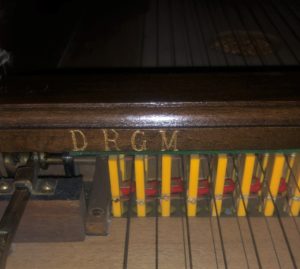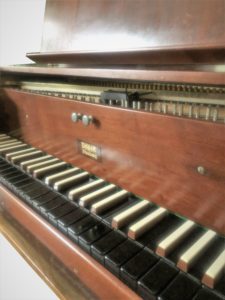Neupert 1940
Description

| Date: | 1940 |
| Origin: | Bamberg |
| Serialnumber: | 16866 |
In the 1920s, interest in Baroque and Renaissance music was revived in Europe, leading to a growing interest in period instruments. At the same time, however, there was a limited number of original instruments available, which created a need for replicas and new instruments. The harpsichord construction experienced a renaissance in the 20th century and numerous instruments were made by different manufacturers. Traditional construction methods and materials were rediscovered and new technical developments were integrated into the manufacture of the instruments.
The renaissance of the harpsichord in the 20th century, led by Wanda Landowska (1879 – 1959), came to a temporary halt during the Second World War. In Germany, the production of musical instruments was severely restricted due to the prioritization of war material.
The Neupert company was one of the leading manufacturers in early 20th century for harpsichords in Germany. During the Second World War, Neupert, like many other companies in Germany, had to contend with the economic challenges of the war years.
In 1939, when war broke out, Neupert’s production was curtailed due to rationing and material shortages. However, the company was able to maintain production and continued to supply harpsichords to customers in Germany and abroad. In the later years of the war, many of Neupert’s employees were drafted into military service and the production further declined.

Harpsichord Neupert, Bamberg 1940 – Eric Feller Collection (9)
The harpsichord described here dates from the war year 1940 and was made by Neupert in Bamberg. It is perfectly preserved, all parts are original and it is in full playable condition.
The case is made of dark walnut and stands on 4 Chippendale-style legs.
The harpsichord has 2 rows of jacks with so-called “Troho jacks” (Trolon plastic-wood jacks), which consist of a wooden core and plastic sides. The quills are made of leather, two registers (8′ and 4′) and a lute stop for the 8′ register, which is divided. The compass is 4 ½ octaves (CC – f3).

Harpsichord Neupert, Bamberg 1940 – Eric Feller Collection (12)
The signature
“Neupert Bamberg”
is located in the middle of the nameboard. The serial number is 16866 and is stamped on the right of the wrest plank. The letters “DRGM“, the abbreviation for “Deutsche Reichs-Gebrauchsmuster“, are stamped on the left and right side of the jack rail and decorated in gold letters. The Deutsche Reichs-Gebrauchsmuster was a system for registering and protecting trademarks and designs in Germany that was in force from 1891 to 1945. It was introduced to offer German companies a way to protect their intellectual property rights and thus create an incentive for innovation and creativity.

Harpsichord Neupert, Bamberg 1940 – Eric Feller Collection (DRGM – Signature)
The Deutsche Reichs-Gebrauchsmuster system worked similarly to the patent or trademark protection system, but with the difference that it focused exclusively on the aesthetic properties of a product. It allowed manufacturers to apply for a utility model patent for their product and thus obtain a protection on the use of the design for a period of up to 15 years. The Deutsche Reichs-Gebrauchsmuster was crucial for many companies as it allowed them to stand out from the competition and create unique products that were appreciated by customers. It was also an important protection against product piracy.
During National Socialism, the Reichs-Gebrauchsmuster was used by the Nazis as an instrument of propaganda. Many products were provided with nationalist or partly racist symbols to promote national pride and to create a unified identity for the people.
After the end of World War II, the Reichsgebrauchsmuster system was abolished and replaced by the Deutsche Gebrauchsmuster, which is still in use in Germany today.

Cembalo Neupert, Bamberg 1940 – Eric Feller Collection (1)
The sound of the instrument is very clear and strong. However, it must be clearly stated here that the sound is not at all comparable with a historical harpsichord. It is a completely new instrument due to its construction, which only has the sound generation in common with the old harpsichords. In comparison to instruments built from the 1960s and 1970s, however, the sound is many times more convincing and beautiful.
| Length: | 139 cm |
| Width: | 78 cm |
| Height: | 25 cm |
| Circumference: | 4 ½ Oktaven C - f3 |
| Mechanics: | wooden jacks (Troho-Springer) with leather quills |
| Pedals: | 2 registers (8' & 4') , lute stop |
| Signature: |
"Neupert Bamberg" |

